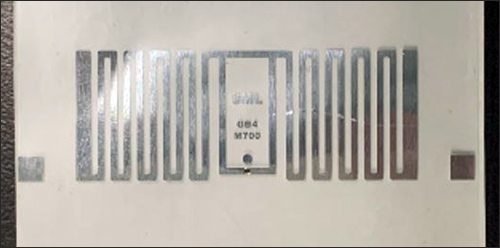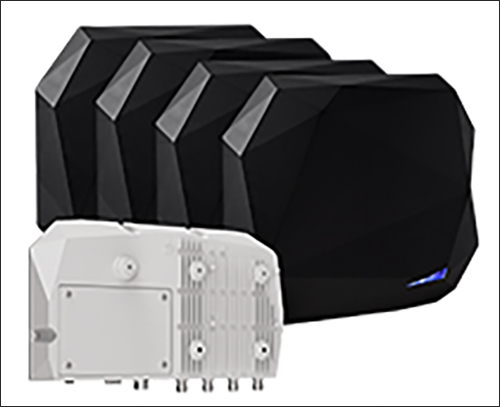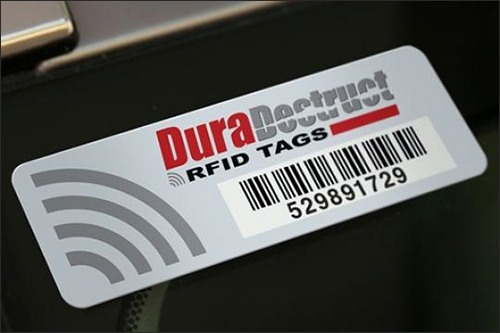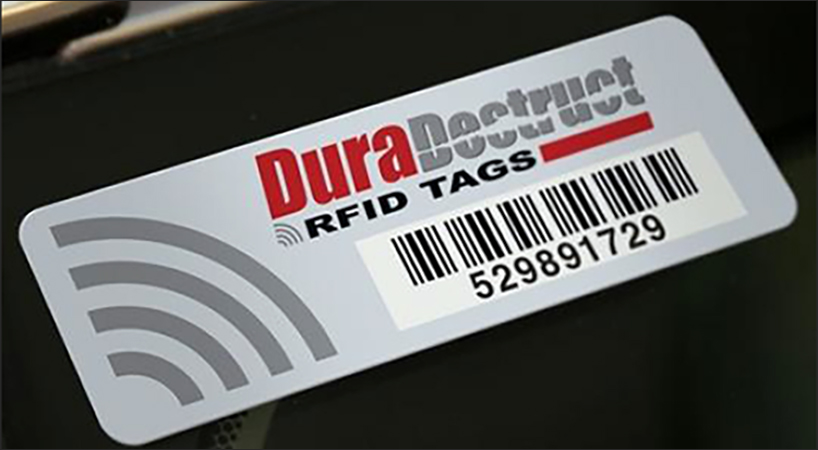Presented here are recent news announcements regarding the following organizations: SML, STid, Metalcraft, Twilio, WiSilica, iGuzzini illuminazione, STMicroelectronics and Senet.
SML Announces New RFID Retail Inlay
SML, a provider of RFID solutions for the retail market, has announced the release of its GB4M700 inlay, which the company says is designed to help retailers boost efficiency and reduce material and shipping costs. The inlay measures 42 millimeters by 16 millimeters (1.7 inches by 0.6 inch) and is intended to increase inventory accuracy and management for omnichannel retailers.

The inlay has a read sensitivity of -24 dBm, with a small antenna and up to 128 bits of Electronic Product Code (EPC) chip memory. It can fit on the majority of tagged products, the company reports, boosting read performance for inventory tracking in large-scale retail deployments. In addition to supporting clothing and denim tags, the inlay can be used for tagging polybags and boxed items.
“SML RFID is committed to delivering the most innovative solutions to empower retailers to better manage their inventory,” said Dean Frew, SML Group’s chief technology officer and senior VP of RFID solutions, in a prepared statement. “As a result, we are continuing to invest in our technology. SML RFID’s design team and operational team, alongside our suppliers and Impinj, have worked relentlessly to deliver the new inlay. The product will extend SML RFID’s innovative legacy and commitment to provide retailers and brand owner customers with innovative RFID solutions.”
STid Offers RFID Readers for Industrial Asset Management
STid has announced its SPECTRE line of multi-antenna RFID readers, designed to safeguard the identification and management of assets in industrial environments. SPECTRE offers high reading performance, the company reports, and provides easy installation and integration for industrial tracking applications. The system is scalable to support future industrial and logistics traceability projects.
According to STiD, the system’s benefits include improved factory throughputs, simplified logistics and production by monitoring conveyors or gantries, and embedded tracking outdoors and in harsh environments (ports, docks, shipyards and so forth). The SPECTRE line offers accessories ranging from connectors, cables and mounting kits to mast and jib crane connections, allowing users to quickly cable and install onsite.

The readers come with a reinforced anti-shock structure (IK10). They are waterproof (up to IP67) and vibration-resistant (MIL–STD-810G) and are also available as an IP53-rated model. The readers can connect four remote antennas, each incorporating an LED and an adjustable buzzer, with the ability to adapt to single- or multi-point reading applications.
The integration of BlockPermalock (compatible with the ATA SPEC 2000 standard) and Untraceable functions enable users to secure identification and protect data integrity. Support and training are available to help users with integration, installation and deployment of traceability projects, the company reports.
Metalcraft Intros RFID Tags for Security Applications
Metalcraft has announced its tamper-proof DuraDestruct RFID tags for applications that require a long read range with durable, secure identity. According to the company, the new tags are designed for use in RFID-based access-control, supply-chain, asset-tracking and authentication. The tags support vehicle identification and other use cases requiring secure identification. Custom printing and numbering are available at no additional cost, Metalcraft reports.

The DuraDestruct tags feature a patent-pending construction that renders labels useless upon tampering or removal. This construction prevents transferability, the company explains, and incorporates dual levels of destructibility. If a person attempts to remove the tag, the antenna will break into separate pieces, reducing the read range to mere inches. If he or she then tries to reassemble the tag to make it functional, the portion still adhered will disintegrate upon removal from the object to which it is attached.
“Metalcraft’s DuraDestruct RFID tags offer peace of mind to access control, supply chain and asset tracking leaders, because these security tags are durable and can’t be transferred,” said Kyle Bermel, the company’s chief operating officer, in a prepared statement. “DuraDestruct provides an additional level of security for RFID anti-theft and RFID protection systems: tracking and authenticating high-value assets. We know these work great on windshield glass for gated communities and vehicle tracking, as well as tracking bins, totes and other returnable containers.”
Twilio Unveils IoT Connectivity and Device-Management Platform
Twilio, a cloud communications platform provider, has announced the expansion of its Internet of Things (IoT) offerings with the launch of its Microvisor IoT connectivity and device-management platform. Micovisor enables embedded developers to build devices, securely connect them to the Internet and then manage them. With Microvisor, Twilio reports, IoT builders can lower development costs and speed up time to market, with Twilio handling security at deployment time and throughout the device’s lifetime.
“With Super SIM, our global cellular IoT connectivity offering, we glimpsed into the IoT projects of leading brands—and saw first-hand the major causes of IoT project failure,” said Evan Cummack, Twilio’s general manager of IoT, in a prepared statement. “Customers are wasting a lot of time wrestling with the foundational aspects of embedded software that are novel to IoT—achieving secure and reliable connectivity, in particular. Microvisor is the only platform that offers embedded developers the conveniences of a fully managed IoT platform, while giving them the freedom to craft their embedded software exactly how they’ve always done.”
To deploy a fleet of connected devices, IoT builders must consider device security, reliable connectivity, over-the-air firmware upgrades and connectivity issues, all of which require specific domain expertise. This complexity, the company notes, results in a high rate of failure for IoT projects. The Microvisor platform is intended to remove many common infrastructure challenges burdening IoT developers, Twilio indicates.
Users pay a one-time fee for continuous monitoring of vulnerabilities, and Twilio applies security patches for devices and cloud components. Developers can debug devices remotely from anywhere in the world, pushing code updates frequently and safely, without worrying about breaking a device due to a bad update. Support is available for any language and embedded OS, the company reports. Microvisor’s architecture lets developers reuse existing embedded code and continue developing in the language and embedded OS of their choice, thanks to Arm‘s TrustZone hardware isolation technology.
WiSilica, iGuzzini Illuminazione Partner on BLE-based Intelligent Lighting
WiSilica, an Internet of Things (IoT) solution provider for smart environments, and iGuzzini illuminazione, a provider of architectural lighting products,have signed a strategic partnership to develop smart solutions for a range of lighting applications. According to the companies, the collaboration is aimed at building a shared know-how in people-centric lighting, in terms of smart light control and smart light services.
The products utilize the Bluetooth Low Energy (BLE) protocol, enabling light to be managed from a mobile device or provide additional information and services for users. With BLE technology included in each device, light becomes portable, the companies explain, facilitating the system’s installation, programming and management. Remote control is made possible by using an IP protocol across a BLE and Wi-Fi interface, either via a smartphone or directly online.
Light can create new smart services for energy administrators and users, the companies indicate. With beacon technology integrated into lighting systems and using the BLE protocol, users can receive digital information by activating proximity marketing services (push notifications), route indications (indoor navigation), or data about the use of spaces (space management) directly on a device. Control devices and intuitive apps provided by WiSilica, combined with iGuzzini’s lighting solutions portfolio, enable applications in places of culture, work settings, retail environments and cities, as well as for infrastructure and for hospitality and living.
“We are excited to partner with iGuzzini and work along a globally recognized professional architectural lighting innovator,” said Suresh Singamsetty, WiSilica’s CEO, in a prepared statement. “Our expertise in wireless capabilities and automation supports iGuzzini in precisely controlling lights and boost energy savings. Further, our DALI-compliant devices enable them with the flexibility to integrate seamlessly into vast ecosystems.” WiSilica offers a location-aware IoT platform called ARIXA, which features smart lighting and real-time location services. The platform integrates hardware, middleware, cloud services and application interfaces to power a range of applications.
“Our aim has always been that of supporting the lighting community by offering as many solutions as possible for their projects worldwide and fulfilling their needs for flexibility and efficiency,” said Massimiliano Guzzini, iGuzzini’s VP and chief marketing officer, in the prepared statement. “Unlike other proprietary standards, the Bluetooth technology enables interoperability, allowing our clients (both designers and end customers) to combine multiple lighting solutions and to optimize the whole system in terms of technology, performances and project costs, thanks to its great adaptability, reliability and ease of use.”
STMicroelectronics Software Facilitates Power-Conscious Building Automation
STMicroelectronics has released its KNX software for the S2-LP ultra-low-power radio transceiver, which is designed to enable energy-saving standardized wireless connectivity for smart-building controls. The software can run on an STM32 microcontroller, or on a BlueNRG-2 Bluetooth Low Energy (BLE) system-on-chip (with an embedded Arm Cortex-M0 core running at 32 MHz and a comprehensive set of I/O peripherals). It contains a certified KNX-RF stack, an RF adaptation layer and the S2-LP library, enabling users to connect the transceiver to create an ultra-low-power wireless KNX node.
Operating in the 868.3 MHz band at 10mA with +10dBm output, the S2-LP is intended to provide secure wireless connectivity and prolong battery run-times. The hybrid KNX-Bluetooth solution is provided in two chips, allowing a smartphone to access KNX-based networks and provide an interface for monitoring, controlling, configuring, provisioning and updating KNX nodes.
Whether hosted on the BlueNRG-2 or STM32 MCU, the KNX-RF software works with push buttons, light switches, occupancy sensors, roller-shutter controls, dimmer actuators and other devices for lighting, heating, HVAC and energy-harvesting systems. The software meets the KNX-RF Multi specification, which supports secure (S mode) encrypted communications and frequency agility, the company reports, with five channels to help avoid interference and permit both fast and slow communication modes to save power. The system allows large numbers of KNX devices to coexist on a network, including listen-before-talk (LBT), fast acknowledge with auto-retry, and support for repeaters.
To create the new software, ST teamed up with Tapko (for the certified KNX stack) and Actimage (for the RF adaptation layer). The S2-LP package, which joins ST’s STKNX integrated transceiver for KNX TP communication over twisted-pair cable, extends the company’s portfolio of certified solutions for smart-building communication. In addition to enabling wired and wireless KNX specifications with these solutions, ST provides embedded software, evaluation tools and mobile apps to foster the development of BLE Mesh and 6LoWPAN networking solutions for smart-building and industrial use cases.
Senet Closes Funding Round to Drive LoRaWAN IoT Network Deployments
Senet, a provider of cloud-based software and services platforms designed to enable connectivity and on-demand network build-outs for the Internet of Things (IoT), has announced that it has secured a $16 million funding round led by Fisk Ventures. The funding will help Senet meet the growing demand for LoRaWAN network deployment and carrier-grade connectivity services, the company reports, as organizations adopt digital solutions for infrastructure improvements, process optimization, safety and security, and contactless data collection.
This funding, which follows an increased demand from the energy and utility sector, will be used to accelerate the deployment and densification of Senet’s LoRaWAN network across the United States to support utility and municipal networks. Built in public, private and hybrid configurations and supported by deployment and business-engagement models, the network supports a variety of municipal, industrial and enterprise initiatives focused on automation, service delivery and sustainability.
Funds will be used to expand global business development and co-marketing activities with network operators, tower companies and radio access network (RAN) providers. To support its Managed Network Services for IoT (MNSi) and RAN Provider Services offerings, Senet is launching incentive-based partner programs to facilitate engagement between network infrastructure companies and IoT solution providers. Initiatives include the coordination of ecosystem engagements for regional and national solution deployment, collaborative promotions in support of public network readiness, and network branding opportunities.
Senet develops its own cloud-based operating system and offers carrier-grade network-management services and support. As part of its growth strategy, the firm says it is offering programs for customers looking to transition from developer networks, crowd-sourced hotspot networks and gateway-based network servers that are not architected to support large-scale IoT initiatives, are prone to unpredictable downtime, and burden end users with the cost and complexity of managing the network.
“Over the past six years, we’ve seen a wide range of businesses embrace IoT and have learned that creating a bridge between the physical and digital worlds is far more complex than most people realize,” said Bruce Chatterley, Senet’s CEO, in a prepared statement. “Building on our experience, and with the support of our investors, we will continue to strive toward delivering ubiquitous low-cost network connectivity, zero-touch device configuration, and device monitoring and management at massive scale, in support of our customers’ needs.”


